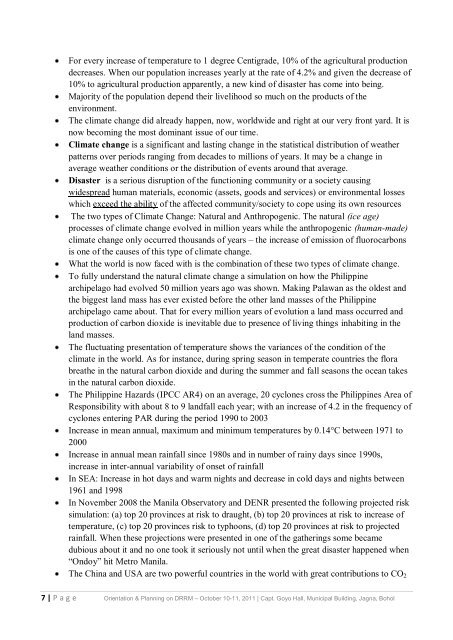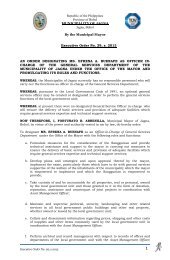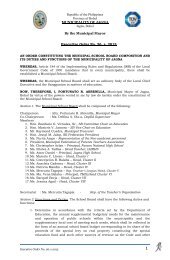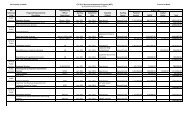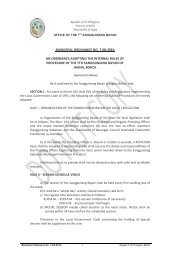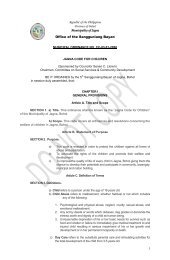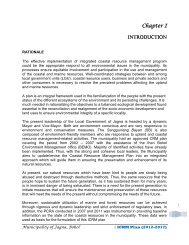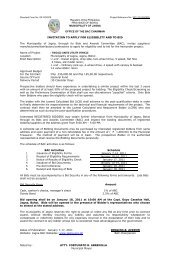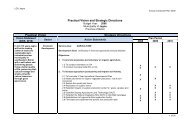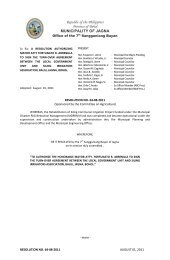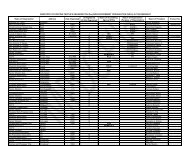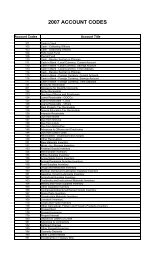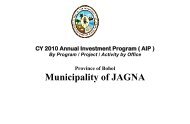DRRM Orientation to Punong Barangays of Jagna
DRRM Orientation to Punong Barangays of Jagna
DRRM Orientation to Punong Barangays of Jagna
You also want an ePaper? Increase the reach of your titles
YUMPU automatically turns print PDFs into web optimized ePapers that Google loves.
For every increase <strong>of</strong> temperature <strong>to</strong> 1 degree Centigrade, 10% <strong>of</strong> the agricultural production<br />
decreases. When our population increases yearly at the rate <strong>of</strong> 4.2% and given the decrease <strong>of</strong><br />
10% <strong>to</strong> agricultural production apparently, a new kind <strong>of</strong> disaster has come in<strong>to</strong> being.<br />
Majority <strong>of</strong> the population depend their livelihood so much on the products <strong>of</strong> the<br />
environment.<br />
The climate change did already happen, now, worldwide and right at our very front yard. It is<br />
now becoming the most dominant issue <strong>of</strong> our time.<br />
Climate change is a significant and lasting change in the statistical distribution <strong>of</strong> weather<br />
patterns over periods ranging from decades <strong>to</strong> millions <strong>of</strong> years. It may be a change in<br />
average weather conditions or the distribution <strong>of</strong> events around that average.<br />
Disaster is a serious disruption <strong>of</strong> the functioning community or a society causing<br />
widespread human materials, economic (assets, goods and services) or environmental losses<br />
which exceed the ability <strong>of</strong> the affected community/society <strong>to</strong> cope using its own resources<br />
The two types <strong>of</strong> Climate Change: Natural and Anthropogenic. The natural (ice age)<br />
processes <strong>of</strong> climate change evolved in million years while the anthropogenic (human-made)<br />
climate change only occurred thousands <strong>of</strong> years – the increase <strong>of</strong> emission <strong>of</strong> fluorocarbons<br />
is one <strong>of</strong> the causes <strong>of</strong> this type <strong>of</strong> climate change.<br />
What the world is now faced with is the combination <strong>of</strong> these two types <strong>of</strong> climate change.<br />
To fully understand the natural climate change a simulation on how the Philippine<br />
archipelago had evolved 50 million years ago was shown. Making Palawan as the oldest and<br />
the biggest land mass has ever existed before the other land masses <strong>of</strong> the Philippine<br />
archipelago came about. That for every million years <strong>of</strong> evolution a land mass occurred and<br />
production <strong>of</strong> carbon dioxide is inevitable due <strong>to</strong> presence <strong>of</strong> living things inhabiting in the<br />
land masses.<br />
The fluctuating presentation <strong>of</strong> temperature shows the variances <strong>of</strong> the condition <strong>of</strong> the<br />
climate in the world. As for instance, during spring season in temperate countries the flora<br />
breathe in the natural carbon dioxide and during the summer and fall seasons the ocean takes<br />
in the natural carbon dioxide.<br />
The Philippine Hazards (IPCC AR4) on an average, 20 cyclones cross the Philippines Area <strong>of</strong><br />
Responsibility with about 8 <strong>to</strong> 9 landfall each year; with an increase <strong>of</strong> 4.2 in the frequency <strong>of</strong><br />
cyclones entering PAR during the period 1990 <strong>to</strong> 2003<br />
Increase in mean annual, maximum and minimum temperatures by 0.14°C between 1971 <strong>to</strong><br />
2000<br />
Increase in annual mean rainfall since 1980s and in number <strong>of</strong> rainy days since 1990s,<br />
increase in inter-annual variability <strong>of</strong> onset <strong>of</strong> rainfall<br />
In SEA: Increase in hot days and warm nights and decrease in cold days and nights between<br />
1961 and 1998<br />
In November 2008 the Manila Observa<strong>to</strong>ry and DENR presented the following projected risk<br />
simulation: (a) <strong>to</strong>p 20 provinces at risk <strong>to</strong> draught, (b) <strong>to</strong>p 20 provinces at risk <strong>to</strong> increase <strong>of</strong><br />
temperature, (c) <strong>to</strong>p 20 provinces risk <strong>to</strong> typhoons, (d) <strong>to</strong>p 20 provinces at risk <strong>to</strong> projected<br />
rainfall. When these projections were presented in one <strong>of</strong> the gatherings some became<br />
dubious about it and no one <strong>to</strong>ok it seriously not until when the great disaster happened when<br />
“Ondoy” hit Metro Manila.<br />
The China and USA are two powerful countries in the world with great contributions <strong>to</strong> CO 2<br />
7 | P a g e <strong>Orientation</strong> & Planning on <strong>DRRM</strong> – Oc<strong>to</strong>ber 10-11, 2011 | Capt. Goyo Hall, Municipal Building, <strong>Jagna</strong>, Bohol


